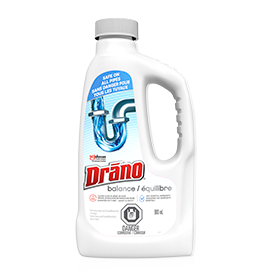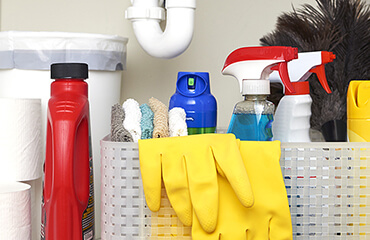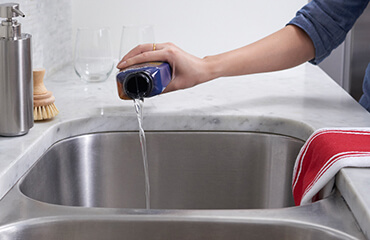How to Get Rid of Smelly Drains
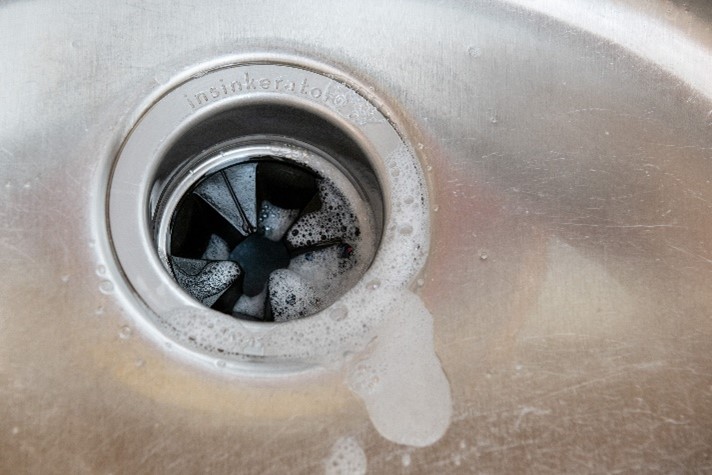
Why your drain smells bad
A stinky drain smell in the house can be frustrating, but once you know the source of the odor, you’re one step closer to fixing the problem. If your drain smells bad, there are a number of possible causes. Here are the most common culprits behind a smelly drain:
- Clogged drain: Clogs are a nuisance – not only do they prevent your drain from functioning properly, but they can also smell pretty gross too. If water is slow to drain or you have standing water collecting above the drain opening, there’s a good chance you’ve got an obstruction in the drain pipe. This can lead to unpleasant drain odor.
- Bacteria or biofilm: Bacteria feed on gunk stuck in the drain – particularly on debris such as food particles, grease, soap scum and hair. While this doesn’t always form a blockage, this gunk can attract bacteria and create biofilm (slimy bacterial waste) that leads to a stinky drain.
- Mildew or mold build up: If you have a musty smell in your drains, there’s a chance that mold is growing inside. You can sometimes see signs of mold around the drain opening or on the surrounding areas, such as in the tiles or on the sealant of a shower. Drains are dark, warm and wet which provides ideal conditions for mold to grow in.
- Plumbing issues: A smelly drain could be caused by a dry or broken P-trap (the U-shaped pipe beneath the drain opening). Normally, the P-trap holds a small amount of water which creates an airtight seal, preventing any sewer gases coming up through the drain. When this water dries out, or if there’s a leak in the pipe, these gases can freely travel from the sewer into the bathroom, kitchen or other room in the house. The P-trap can also sometimes get too full which leads to a blockage forming deeper in the pipe.
Why do my drains smell like sewage?
If you notice a sewer smell coming from one or more of the drains in your home, it could indicate a problem with the ventilation system or water tank.
Sometimes the air vent on the roof can become blocked with debris such as leaves and twigs. The sewer vent allows air to flow through the plumbing system in the house and keep sewer gases from re-entering through the drains. If this vent is obstructed, the sewer gas smell escapes into your house and causes the nasty rotten egg smell in the drains. You can test for a blocked vent by running water through the smelly drain and flushing the nearest toilet. If you hear gurgling sounds coming from the drain, this means that water flow from the toilet is sucking air through it and there’s a chance that the ventilation is compromised.
Less frequently, the water itself can cause your drain to smell like sulfur. Sometimes the water tank can become contaminated which causes the water to smell. To check if you have this problem, you can perform the glass test. Simply fill a glass of water from the suspected source of the stinky drain, then fill another glass from a different room in the house. If both glasses smell bad, then the water is likely to be contaminated. If only one glass smells, then the issue is with one drain – and it’s possible there’s buildup inside the faucet itself.
Note: A sewage smell in your drains should be attended to immediately. Sewer gas can build up and lead to health problems and even hydrogen sulfide poisoning. It’s also flammable in large enough quantities, so poses a risk for explosion. Therefore, addressing the issue as soon as possible is the best way you can avoid safety hazards.
How to clean a smelly drain
Now you know the possible causes of the bad smell in your drain, we’ll now talk you through our tips for how to fix a smelly drain.
Clean the drain opening
Before getting started on the various remedies for deodorizing a drain, you should first clean any debris in and around the drain’s surface. For a kitchen drain, this means cleaning out the drain strainer or the rubber flaps of a garbage disposal, and in a bathroom drain this means removing any hair or debris caught in the drain opening. You may need to unscrew the drain cover with a screwdriver or by twisting it to gain access to the drain. Soap, water and an abrasive sponge should be enough at this stage to remove surface level grime that could be causing nasty drain odors.
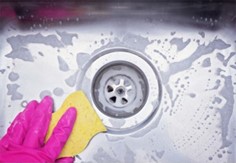
Hot water method
As simple as it sounds – pouring hot water into the drain can help to melt away gunk and bacteria lurking inside, getting rid of bad drain smells in the process. All you need to do is bring a kettle or large pot of water to the boil, then carefully pour the water into the drain opening. Afterwards, flush the drain with more water to clear any remaining debris. Make sure not to use boiling water in your drain if you have PVC pipes as this can soften or damage them.
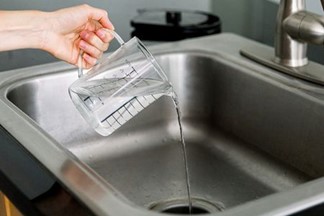
Vinegar and baking soda
Perhaps one of the most popular and effective DIY drain odor removers – a baking soda and vinegar solution produces a chemical reaction to fizz away any debris or build up clinging to the pipes and neutralizes smells as a bonus. For this method, pour ½ cup baking soda into the drain opening, then follow this with 1 cup of vinegar. The ingredients will start to react, so plug the drain with a stopper or old rag to seal in the solution. Wait for 30 minutes – 1 hour, then flush the mixture from the drain with hot water. Tip: Add a few drops of essential oils to the drain to get rid of the strong vinegar smell.
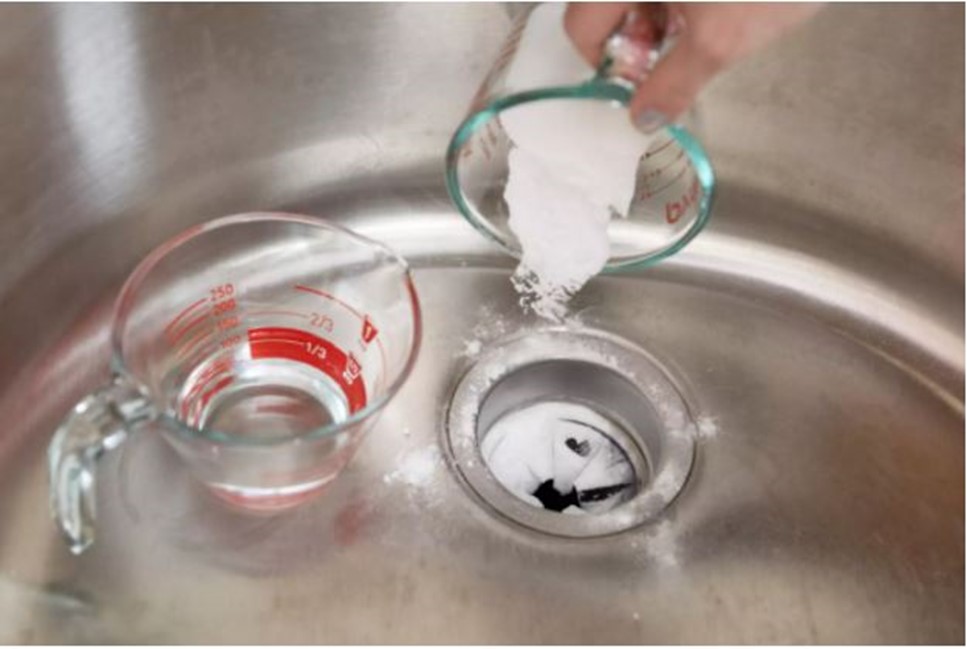
Use bleach
Bleach works well to sanitize and deodorize a drain – and is particularly effective when you have mildew or biofilm build up. However, you should always use bleach with caution – consistent use can damage some pipes. After you’ve cleaned the drain opening, pour about half a cup of bleach into the drain and let it sit for 30 minutes – 1 hour. Flush the drain with hot water to clear any bleach or debris away.
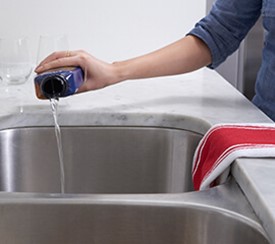
Use Drano®
Using a professional drain smell cleaner such as Drano® is a really effective way to get rid of drain odors while feeling confident that the formula isn’t damaging the pipes. Depending on which drain is affected, you’ll need to choose a Drano® product suited to that particular drain. You can find information on all products safe to use in bathroom drains, kitchen drains, garbage disposals and more here. A good all-rounder is Drano® Max Gel Clog Remover, which can be used on most household drains. This formula helps to cut through lingering debris and cleanses the insides of pipes to banish blockages and bad smells in the drain. Just pour it in, wait for 15-30 minutes then flush with hot water!
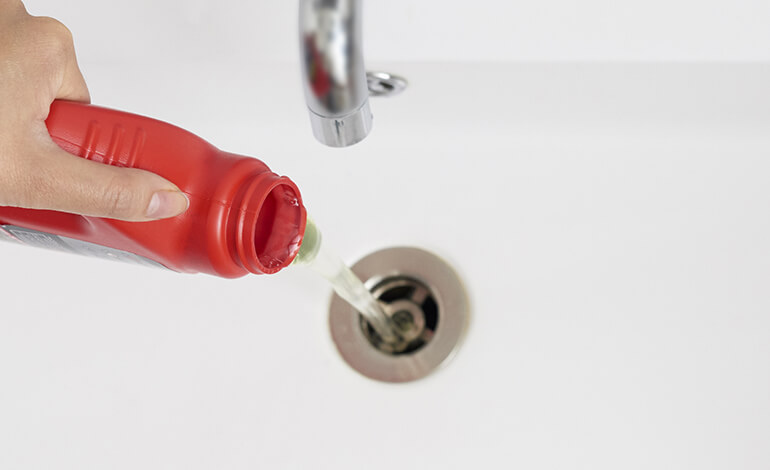
Clean the P-trap
If these methods haven’t solved your smelly drain problems, then perhaps the pesky P-trap is to blame. A dry P-trap is a common cause for smells in underused drains, so you should try running water through the sink or shower first of all to make sure this isn’t the issue. If you do use the drain regularly, examine the P-trap for leaks or damage – this could also be causing the water level in the P-trap to lower. Sometimes the drain may need a deep clean, and this involves removing the P-trap altogether and giving it a rinse. You can find out more about how to clean a P-trap in our guide to unclogging a drain.
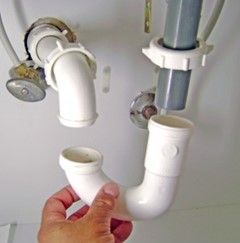
Check the sewer vent
If you’ve identified a problem with the ventilation, then you’ll need to manually inspect the sewer vent to check for blockages. If you’re confident enough, you can check the vent yourself by climbing up on the roof and fishing out debris, but if you’re not comfortable with this, it’s best to call a plumber.
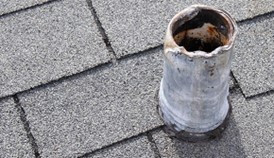
Replace the anode rod in the water tank
If your issue is contaminated water and not the drain itself, there’s a chance that it’s down to the anode rod in the water heater reacting to bacteria. This typically occurs when there’s an old magnesium anode rod. Fixing this issue requires replacing it with a new aluminum rod and disinfecting the water with hydrogen peroxide. Again, this is a more complicated process which is not as simple as the other DIY methods. Seek the assistance of a professional if you’re not comfortable doing this yourself.
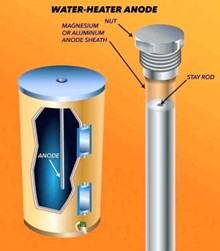
If you are unsure why your drain smells bad, or if you are not confident to attempt these methods yourself, please don’t hesitate the seek professional assistance.
These are general methods of drain deodorizing which can be used in most scenarios, but if you’re looking for more specific advice, view our guides for showers, bathroom sinks, kitchen sinks, dishwashers and garbage disposals .
Have You tried?
Preventing a stinky drain
While you now know how to fix stinky drains, learning about proper drain maintenance and preventing drain clogs in the first place is the best way you can avoid unpleasant drain odor. Here are some everyday tips on how to make drains smell better:
- Regular cleaning: Clean the drain on a regular basis to prevent grime build up. Use a homemade vinegar and baking soda drain cleaner every few weeks or use boiling water and lemon to freshen up your drain. You can also use Drano® Max Build-Up Remover once a month to keep your drains running smoothly.
- Be drain-smart: Be careful what you throw into the drain, as this can lead to clogs and bad smells. Avoid pouring oil or grease into kitchen sinks and garbage disposals as this can be a catalyst for clogs and microbial growth.
- Stop that scum: If you haven’t got one already, then it’s definitely a good idea to invest in a drain cover to catch any food debris or hair clogs before they form. You can purchase these for all types of drains online or at your local homeware store.
- Don’t neglect underused drains: Run water through lesser used sinks or showers every few weeks to stop the P-trap drying out and causing a smelly drain.
- Organize maintenance checks: Schedule maintenance checks with a plumber once a year to ensure that your drains are functioning properly. This is a measure that even die-hard DIYers still need to comply with.
With these tips, you’ll be prepared to fix a stinky drain any day of the week! If you’re curious to learn more about general household drain maintenance and discover solutions to everyday problems, explore the Clog Basics blog page.
Discover Drano® products suitable for all kinds of drain drama by browsing our complete range. Always read the instructions to check how to safely use Drano®.
